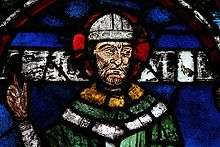The Fermo chasuble of St. Thomas Becket
The Fermo chasuble of St. Thomas Becket is a garment belonged to Thomas Becket, Archbishop of Canterbury from 1162 until his murder in 1170.
On display at Museo Diocesano in Fermo, the chasuble is among the possessions of the treasury of the Fermo Cathedral (Duomo di Fermo). It was donated by Presbitero, bishop of Fermo (1184-1201), who had received it from Thomas Becket himself, when they were both students at the Studium of Bologna.
The vestment is one of the most magnificent medieval textiles in the Mediterranean area and has revealed to be the earliest fully dated and localised major Islamic embroidery known.[1]
History

Back from Paris, where he studied theology and rhetoric, at the age of 24 Becket was introduced to Archbishop Theobald, a former abbot of Bec, of whose household he became a member. Thomas won Theobald's confidence, acted as his agent and was sent by him to study civil and canon law at Bologna. In Bologna Becket met Presbitero, a student from Fermo, who is said to have received the chasuble as a gift from Becket himself. Though there is no historical evidence of this occurrence, two documents, preserved at Archivio Storico Arcivescovile (Historical Archiepiscopal Archive) in Fermo, prove the existence of a link between Thomas Becket and Fermo: the former, dating back to 1296, certifies the existence of a church consecrated to the memory of Thomas Becket, in the surroundings of Fermo; the latter, dating back to 1686, signed by Cardinal Giovanni Francesco Ginetti, makes mention of the chasuble in Fermo.
In 1925, Cardinal Rafael Merry del Val asked for the chasuble to be pulled out of its precious case. In 1937, the chasuble appeared as one of the major artworks in the Rome Exhibition; in 1951, in Paris; in 1961 in Barcelona. In 1973, UK television talked extensively about the chasuble when it was on display in London, where Queen Elizabeth admired it.
Description
Originally preserved inside a wooden box decorated in gold with gemstones, the semi-circular chasuble is 1,6 m high and has a circumference of 5,41 m. It is made of light-blue silk and decorated in gold thread embroidery.[2] The embroidery consists of 34 large roundels interlinked with smaller roundels and eight-pointed stars. The large roundels on the outside of the garment show representations of peacocks, two winged lion griffins, four eagle griffins, frontalised eagles with spread wings, confronted birds, confronted winged lions, some rapacious birds atop gazelles, a winged sphinx, and fragments of other animals. There are also representations of elephants with howdahs, one with women inside; four groups of turbaned hunters holding falcons seated on horses with rabbits below, and two enthroned men flanked by musicians and other attendants. An oblong panel with a lavish scroll contains this Kufic inscription: "In the name of Allah the Merciful, the Compassionate, the kingdom is Allah's...greatest blessing, perfect health and happiness to its owner...in the year 510 in Mariyya".
The chasuble is made up of different parts sewn together with red silk; some portions were sewn before the embroidery process, others afterwards, making the embroidery itself discontinuous. It is thus likely that the textile was readjusted as a sacred garment after having been employed for a different purpose.
Studies
The chasuble is a major example of the process of Christianisation of an Islamic textile; the Arabic inscription on the chasuble allows scholars to ascribe the textile to a laboratory working during the Islamic period in Spain. The christianisation process is proven both by the fact that the textile became a garment used in Christian liturgy and by its association with the worship of Thomas Becket as saint and martyr, which spread all over Europe during the 13th century.[3]
Professor David Storm Rice, from University of London, studied the chasuble extensively and was the first to detect and decipher the inscription on the textile, which he revealed in his article for The Illustrated London News in 1959.
Furthermore, due to its importance and exceptional state of preservation, the chasuble has recently undergone thorough analysis by the art historian Avinoam Shalem, who studied the textile and its history in collaboration with a team of internationally renowned experts.
Notes
- ↑ Storm Rice David, Illustrated London News, 3rd October 1959, pp. 356-58
- ↑ Simon-Cahn, Annabelle, The Fermo Chasuble of St. Thomas Becket and Hispano-Mauresque Cosmological Silks: some speculations of the adaptive reuse of textiles
- ↑ Dolezalek, Isabelle, Arabic Script on Christian Kings: Textile Inscriptions on Royal Garments
Bibliography
- Dolezalek, Isabelle, Arabic Script on Christian Kings: Textile Inscriptions on Royal Garments, De Gruyter, Berlin/Boston, 2017
- Payne, Alina, Dalmatia and the Mediterranean: Portable Archaeology and the Poetics of Influence, Brill, Leiden, 2014
- Shalem, Avinoam, The Chasuble of Thomas Becket, a biography, Hirmer Publishers, 2016
- Simon-Cahn, Annabelle, The Fermo Chasuble of St. Thomas Becket and Hispano.Mauresque Cosmological Silks: some speculations on the adaptive reuse of textiles, Muqarnas, Vol. 10, Essays in Honor of Oleg Grabar (1993), pp. 1-5